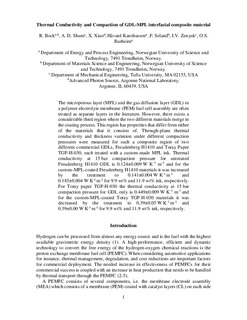| dc.contributor.author | Bock, Robert | |
| dc.contributor.author | Shum, A. D. | |
| dc.contributor.author | Xiao, X. | |
| dc.contributor.author | Karoliussen, Håvard | |
| dc.contributor.author | Seland, Frode | |
| dc.contributor.author | Zenyuk, Iryna V. | |
| dc.contributor.author | Burheim, Odne Stokke | |
| dc.date.accessioned | 2019-01-16T12:25:50Z | |
| dc.date.available | 2019-01-16T12:25:50Z | |
| dc.date.created | 2018-12-15T12:54:53Z | |
| dc.date.issued | 2018 | |
| dc.identifier.citation | Journal of the Electrochemical Society. 2018, 165 (7), F514-F525. | nb_NO |
| dc.identifier.issn | 0013-4651 | |
| dc.identifier.uri | http://hdl.handle.net/11250/2580875 | |
| dc.description.abstract | The microporous layer (MPL) and the gas diffusion layer (GDL) in a polymer electrolyte membrane (PEM) fuel cell assembly are often treated as separate layers in the literature. However, there exists a considerable third region where the two different materials merge in the coating process. This region has properties that differ from either of the materials that it consists of. Through-plane thermal conductivity and thickness variation under different compaction pressures were measured for such a composite region of two different commercial GDLs, Freudenberg H1410 and Toray Paper TGP-H-030, each treated with a custom-made MPL ink. Thermal conductivity at 15 bar compaction pressure for untreated Freudenberg H1410 GDL is 0.124 ± 0.009 W K-1 m−1 and for the custom-MPL-coated Freudenberg H1410 materials it was increased by the treatment to 0.141 ± 0.004 W K−1 m−1 and 0.145 ± 0.004 W K-1 m−1 for 9.9 wt% and 11.9 wt% ink, respectively. For Toray paper TGP-H-030 the thermal conductivity at 15 bar compaction pressure for GDL only is 0.449 ± 0.009 W K−1 m−1 and for the custom-MPL-coated Toray TGP-H-030 materials it was decreased by the treatment to 0.39 ± 0.05 W K−1 m−1 and 0.39 ± 0.00 W K−1 m−1 for 9.9 wt% and 11.9 wt% ink, respectively. | nb_NO |
| dc.language.iso | eng | nb_NO |
| dc.publisher | Electrochemical Society | nb_NO |
| dc.title | Thermal Conductivity and Compaction of GDL-MPL Interfacial Composite Material | nb_NO |
| dc.type | Journal article | nb_NO |
| dc.type | Peer reviewed | nb_NO |
| dc.description.version | acceptedVersion | nb_NO |
| dc.source.pagenumber | F514-F525 | nb_NO |
| dc.source.volume | 165 | nb_NO |
| dc.source.journal | Journal of the Electrochemical Society | nb_NO |
| dc.source.issue | 7 | nb_NO |
| dc.identifier.doi | 10.1149/2.0751807jes | |
| dc.identifier.cristin | 1643643 | |
| dc.description.localcode | © 2018. This is the authors' accepted and refereed manuscript to the article. The final authenticated version is available online at: http://jes.ecsdl.org/content/165/7/F514 | nb_NO |
| cristin.unitcode | 194,64,25,0 | |
| cristin.unitcode | 194,66,35,0 | |
| cristin.unitname | Institutt for energi- og prosessteknikk | |
| cristin.unitname | Institutt for materialteknologi | |
| cristin.ispublished | true | |
| cristin.fulltext | postprint | |
| cristin.qualitycode | 2 | |
